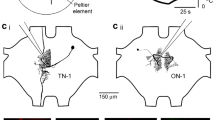Summary
-
1.
The auditory system of the ventral nervous cord was studied in the following species of Tettigoniidae:Tettigonia viridissima, Decticns albifrons, Eupholidoptera chabrieri, Ephippigera spec.
-
2.
The response patterns of 4 second order neurons can be found and classified in both sides of the nervous cord in male and female Tettigoniidae. One type (TT-neuron) is the equivalent of the T-neuron found by Suga and Katsuki (1961) inGampsocleis buergeri.
-
3.
The AT-neuron shows a tonic reaction to frequencies in the range of 1–25 kcps. The number of spikes increases with increasing intensity and duration of stimulation (Fig. 10).
-
4.
The reaction of the DT-neuron is independent of stimulus intensity, duration and frequency (1–40 kcps). It responds with only one spike per stimulus.
-
5.
The TT-neuron responds to frequencies in the range of 5–40 kcps. The stimulus duration of 10–40 ms produces the highest numbers of spikes. The response patterns of the TT-neuron in both sides of the nervous cord are dependent on the position of the sound source. The different response patterns of the ipsi- and contralateral sides are produced by inhibitory interactions (Figs. 2 and 3).
-
6.
The neuron of “large latency” shows a tonic reaction to frequencies in the range of 1–35 kcps. Intensities of 60–80 dB are preferred. This neuron is characterized by its latency of 20–30 ms. It was found only in the suboesophageal ganglion.
The neurons specified by the index T have a T-structure. Their impulses are conducted with the same discharge patterns to the supraoesophageal, meso-, and metathoracic ganglia.
Zusammenfassung
-
1.
Die Hörbahn im Bereich des Bauchmarks wurde bei folgenden Tettigoniidenarten elektrophysiologisch untersucht:Tettigonia viridissima, Decticus albifrons, Eupholidoptera chabrieri, Ephippigera spec.
-
2.
Die Antwortmuster von 4 Sekundärneuronen wurden sowohl bei Männchen als auch bei Weibchen auf beiden Seiten des Bauchmarks gefunden. Ein Neuronentyp (TT-Neuron) entspricht dem von Suga und Katsuki (1961) beschriebenen T-Neuron, abgeleitet beiGampsocleis buergeri.
-
3.
Das AT-Neuron reagiert tonisch in einem Frequenzbereich von 1–25 kHz. Mit steigender Intensität und Reizdauer nimmt die Anzahl der Impulse zu (Abb. 10).
-
4.
Das DT-Neuron reagiert immer nur mit einem Spike auf Schallreize beliebiger Intensität, Dauer und Frequenz (1–40 kHz).
-
5.
Das TT-Neuron reagiert in einem Frequenzbereich von 5–40 kHz bevorzugt auf Schallreize von 10–40 ms Dauer. Längere Reize rufen on-Antworten hervor. Die Antwortmuster der TT-Neuronen beider Seiten des Bauchmarks sind von der Richtung der Schallquelle abhängig. Die unterschiedlichen Antwortmuster — abgeleitet auf der ipsi- und kontralateralen Seite — werden durch hemmende Interaktionen hervorgerufen (Abb. 2 und 3).
-
6.
Das Neuron mit „großer Latenz” reagiert tonisch in einem Frequenzbereich von 1–35 kHz bevorzugt auf mittlere Intensitäten (60–80 dB). Wesentliches Charakteristikum dieses Neurons ist seine große Latenz (20–30 ms). Dieses Neuron wurde nur im Unterschlundganglion gefunden.
Alle anderen mit dem Index T versehenen Neuronentypen haben T-Struktur. Sie leiten ihre Impulse in gleichen Antwortmustern sowohl zum Oberschlundals auch zum Mesobzw. Metathorakalganglion.
Similar content being viewed by others
Literatur
Autrum, H.: Über Lautäußerungen und Schallwahrnehmung bei Arthropoden II. Das Richtungshören vonLocusta und Versuch einer Hörtheorie für Tympanalorgane vom Locustidentyp. Z. vergl. Physiol.28, 326–352 (1940).
Autrum, H.: Über Gehör- und Erschütterungssinn bei Locustiden. Z. vergl. Physiol.28, 580–637 (1941).
Autrum, H.: Phasische und tonische Antworten vom Tympanalorgan vonTettigonia viridissima. Acustica10, 339–348 (1960).
Antrum, H., Schwartzkopff, J., Swoboda, H.: Der Einfluß der Schallrichtung auf die Tympanal-Potentiale vonLocusta migratoria. Biol. Zbl.80, 385–402 (1961).
Kalmring, K.: Akustische Neuronen im Unterschlundganglion der WanderheuschreckeLocusta migratoria. Z. vergl. Physiol.72, 95–110 (1971).
Kalmring, K., Rheinlaender, J., Rehbein, H. G.: Akustische Neuronen im Bauchmark der WanderheuschreckeLocusta migratoria. Z. vergl. Physiol., im Druck.
Katsuki, Y., Suga, N.: Electrophysiological studies on hearing in common insects in Japan. Proc. Jap. Acad.34, 633–638 (1958).
Katsuki, Y., Suga, N.: Neural mechanism of hearing in insects. J. exp. Biol.37, 279–290 (1960).
Suga, N.: Central mechanism of hearing and sound localization in insects. J. Ins. Physiol.9, 867–873 (1963).
Suga, N., Katsuki, Y.: Central mechanism of hearing in insects. J. exp. Biol.38, 545–558 (1961).
Suga, N., Katsuki, Y.: Pharmacological studies on the auditory synapses in a grasshopper. J. exp. Biol.38, 759–770 (1961).
Author information
Authors and Affiliations
Additional information
Mit Unterstützung der Deutschen Forschungsgemeinschaft aus dem Programm des SFB 114 (Bionach).
Herrn Prof. Dr. J. Schwartzkopff danken wir für die kritische Durchsicht des Manuskriptes. Frau Ch. Klotz und Herrn A. Wilmes sind wir für technische Hilfe dankbar.
Rights and permissions
About this article
Cite this article
Rheinlaender, J., Kalmring, K. & Römer, H. Akustische Neuronen mit T-Struktur im Bauchmark von Tettigoniiden. J. Comp. Physiol. 77, 208–224 (1972). https://doi.org/10.1007/BF00693607
Received:
Issue Date:
DOI: https://doi.org/10.1007/BF00693607




